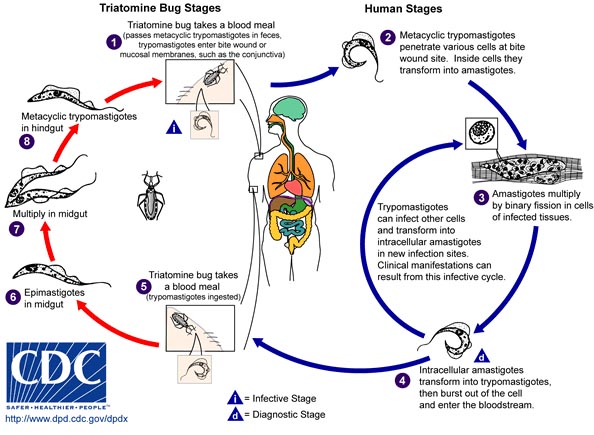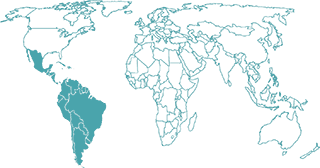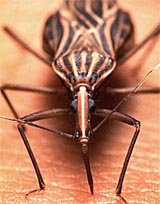Quick Facts
|
Chagas disease is caused by the parasite Trypansoma cruzi (T. cruzi) which is transmitted via the feces of an infected triatomine bug. In the early stages of infection, symptoms are flu-like with local swelling at the site of infection. After 4–8 weeks the immune system depletes much of the parasite from the body, and individuals usually enter an asymptomatic phase called the indeterminate phase of infection. Eventually 20-40% of infected individuals will develop life-threatening heart and digestive system disorders (called chronic phase of infection). Nifurtimox and benznidazole are currently the only available therapies for Chagas disease. Both drugs are mutagenic and have serious side effects, resulting in patients frequently abandoning the lengthy course of treatment (60-120 days). While the efficacy and safety of benznidazole in patients with chronic Chagas disease are being investigated in the ongoing clinical trials BENEFIT and TRAENA, significant efforts have been made to reporpose antifungal azole drugs for Chagas diseases patients. These efforts led to recent clinical trials of posaconazole (Noxafil, Merck) and ravuconazole (Eisai, Tokyo). Both drugs' disappointingly low efficacy against Chagas disease over long time frame demonstrates that discovery of new anti-Chagasic agents remains a high research priority.
What is it?
The main route of infection by T. cruzi is through the triatomine bug. A triatomine becomes infected with T. cruzi by feeding on the blood of an infected person or animal. Once an infected triatomine bites and ingest blood, they defecate, leaving feces containing T. cruzi parasites (trypomastigotes) near the site of the bite wound. The trypomastigote enters via the bite wound site, or through intact mucous membranes, such as the eyes, nose or mouth. Once inside the host, the trypomastigotes invade cells, where they change into amastigotes. The amastigotes multiply and then turn back into trypomastigotes and cause cell rupture, allowing release of the trypomastigotes into the bloodstream and an opportunity to infect a new cell. Other common routes of initial infection are from a mother to her fetus, blood transfusion, organ transplant, and consumption of contaminated food or beverages.
The symptomatic chronic stage affects the nervous system, digestive system and heart. These symptoms are due to killing of affected tissue, and corresponding inflammation and scarring. If left untreated, Chagas disease can be fatal, in most cases due to heart muscle damage.

Where does it occur?
 Chagas disease is found mainly in Central and South America. Approximately 7-8 million people are infected by T. cruzi in Latin America, with over 100 million people at risk of infection. Generally, those at high risk are poor people living in rural areas in primitive housing or mud huts that facilitate close contact between the insect that carries the parasite and humans. The annual economic loss in Latin America due to early morbidity and mortality from Chagas disease has been estimated to be as high as $18 billion – a large economic burden for countries in the developing world. In spite of the enormous health and economic burden caused by Chagas disease, no new drugs to treat Chagas disease have been developed in decades.
Chagas disease is found mainly in Central and South America. Approximately 7-8 million people are infected by T. cruzi in Latin America, with over 100 million people at risk of infection. Generally, those at high risk are poor people living in rural areas in primitive housing or mud huts that facilitate close contact between the insect that carries the parasite and humans. The annual economic loss in Latin America due to early morbidity and mortality from Chagas disease has been estimated to be as high as $18 billion – a large economic burden for countries in the developing world. In spite of the enormous health and economic burden caused by Chagas disease, no new drugs to treat Chagas disease have been developed in decades.
Parasite-infected insects have also been found throughout southern and central United States. This distribution, combined with international travel and immigration patterns, indicates there is cause for epidemiologic concern in the United States, Canada, and other developed countries. An 18-month period of screening blood donations in a subset of United States donation centers found greater than 500 cases of T. cruzi infections, leading to a projection of as many as 300,000 infected persons in the United States alone (Center for Disease Control, 2009).

 Adult Rhodnius prolixus taking a blood meal through human skin. WHO/TDR/Stammers
Adult Rhodnius prolixus taking a blood meal through human skin. WHO/TDR/Stammers